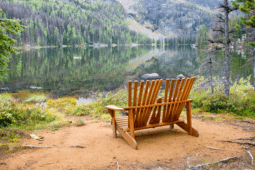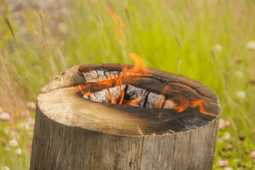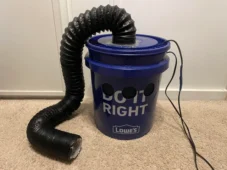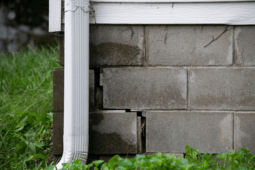The Inconstant Gardener: Misadventures in Landscaping
A part of me retches at the very word ‘landscaping’, as if the 1/4-acre parcel I inhabit on the vast surface of our billions-of-years-old planet somehow requires a few hours per weekend of my inexpert, indifferent care. Come on; any scaping we do to the land will be obliterated by the pitiless passing of time. We might as well lie under our beds ‘scaping’ dust into piles.
Still, that’s a tough argument to make to your neighbors when they walk past your overgrown garden, over the shin-high weeds in the sidewalk cracks, and through the ‘native habitat restoration’ area you call your front lawn. They don’t have to say much, but even at a distance you can see the raising of eyebrows.
Not that I care that much what they think; horticultural conformism be damned. But seriously, this summer the front of our house was getting to a point that would make even the most hardened iconoclast a little embarassed.

So, with a shrug of my shoulders and a roll of the eyes, we decided to finally do a little landscaping. It’s been at least five years since we’ve done so much as weeding in the front, so things were a little, um, hairy. Read on to see how we improved it, and watch a video of the whole process…

We started with a trip to our local True Value store (we’re part of their 2011 blog squad, and have been doing a series of sponsored posts with their help). Not all True Values have a nursery, so we had to call around to a few to find one that did. It was a good thing, too; when we got there, we found the staff really helpful and knowledgable. We described the area we wanted to re-plant, and they helped us find plants that would likely work given the light and soil conditions.
We bought, well, all kinds of stuff. So much I can’t really remember. Since the garden is on a pretty steep slope, we looked for things that would spread and cover (like sedum, sweet woodruff, flox). We also found some nice decorative grasses for more height, and some native wildflowers for color (and butterflies!).

In addition to plants, we loaded up some other supplies we knew we’d need; mulch (about 15 bags of it on that first trip), landscaping fabric, landscaping staples, and edging.

When we got home, we set about cleaning up the overgrowth. I proposed using machetes, but Alicia nixed that on safety grounds (also we don’t have any). Instead, we used our hands (mostly) to pull, yank, and otherwise dislodge the unwanted elements that had long been squatting there. We filled up dozens of wheelbarrow-loads full of grass, weeds, and stuff that might have been actual ‘good’ plants but we didn’t have a clue so, out with them!
In a couple of hours, the garden was looking a lot better, and it was time to start putting in plants (landscaping is actually pretty simple when you get right down to it). We laid everything out above ground first to see how we liked the layout. After several adjustments for color, height, and variety, we put shovels in the ground.


The planting was done (as well as a good soak long saok with the hose; they say that first soaking is the most important), so we put down landscaping fabric. I don’t really like the idea of covering the ground with black plastic to keep things (weeds) from growing up. But I like the idea of weeding even less, so I yielded.
Next came a god-awful amount of putting down mulch. Fifteen bags didn’t even get us halfway, so another True Value trip was needed. A fresh coat of mulch will do wonders for any garden, but unfortunately it’s as impermanent as everything else, and I’m sure we’ll be replenishing ours at least once a year (especially with the slope, as the mulch has a tendency to slide down in the rain).

On one of our last mulch-runs, we also grabbed a set of affordable (but snappy-looking) solar-powered garden lights, and a can of exterior wood stain (for our aging stairway railing).


After about 15 hours of work (spread out over a few weekends), the garden was really looking great. But the top edge was looking not-so-great. Where the garden met the edge of the front yard, there were about three feet of steeply sloped grass-age (word?). This was a pain to mow (hills + lawn-mowers = bad) and looked sloppy.

So, my final landscaping touch was to extend the garden about three more feet up the hill, thereby reducing the grass cover by three feet, saving myself the hassle of having to mow any non-flat sections (since they’d be covered by garden).

This was, oh, about twelve times more work than I hoped it would be. I had to dig out a 3-foot by 30-foot area of sod (moving said sod to other areas of the yard that needed it). Then I had to install landscape edging and paver stones (I had some left over from another project) to make a separation between yard and garden. And then I had to cover all that area up with (sigh) more mulch and a few more plants.


All told; just that ‘garden-extension’ part of the project took me a solid 20 hours. It looks nice, but man, if I knew then what I know now.
We wrapped everything up by putting down a little lawn-patch (grass seed mixed with fertilizer and shredded newspaper), and doing a quick coat of wood stain on the stairway railing. The finished result is, if not downright stunning, at least not injurious to anyone’s eyebrows, and it makes me feel a misplaced tinge of pride every time I pull up to the house.
This video sums it all up pretty nicely:
And here are some more pictures for your scrolling pleasure:












